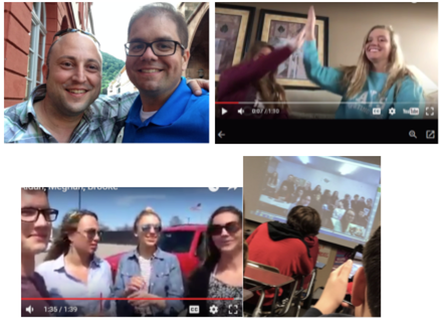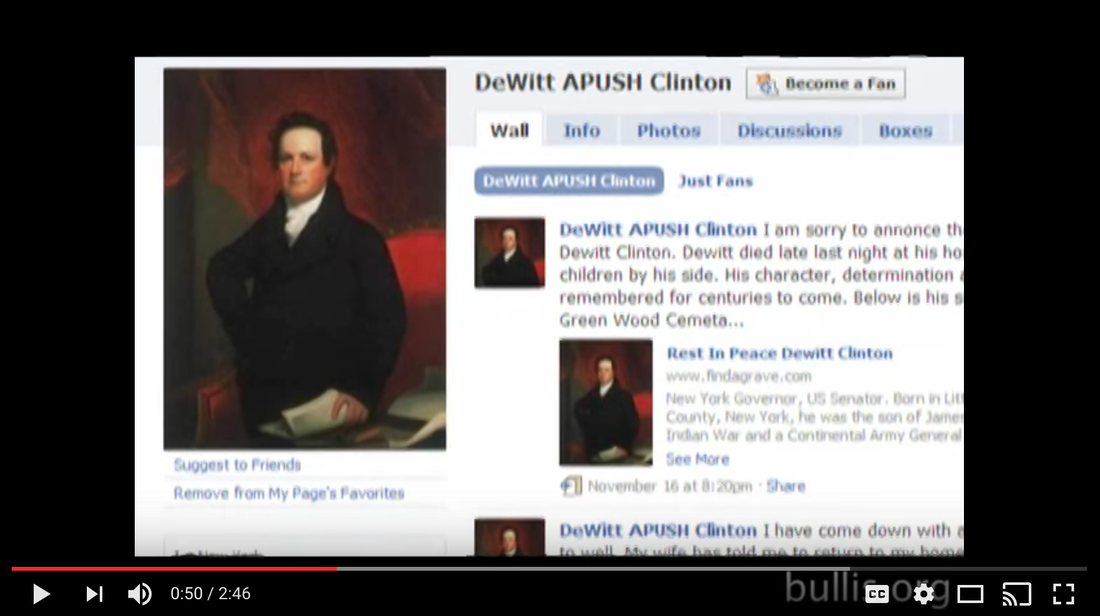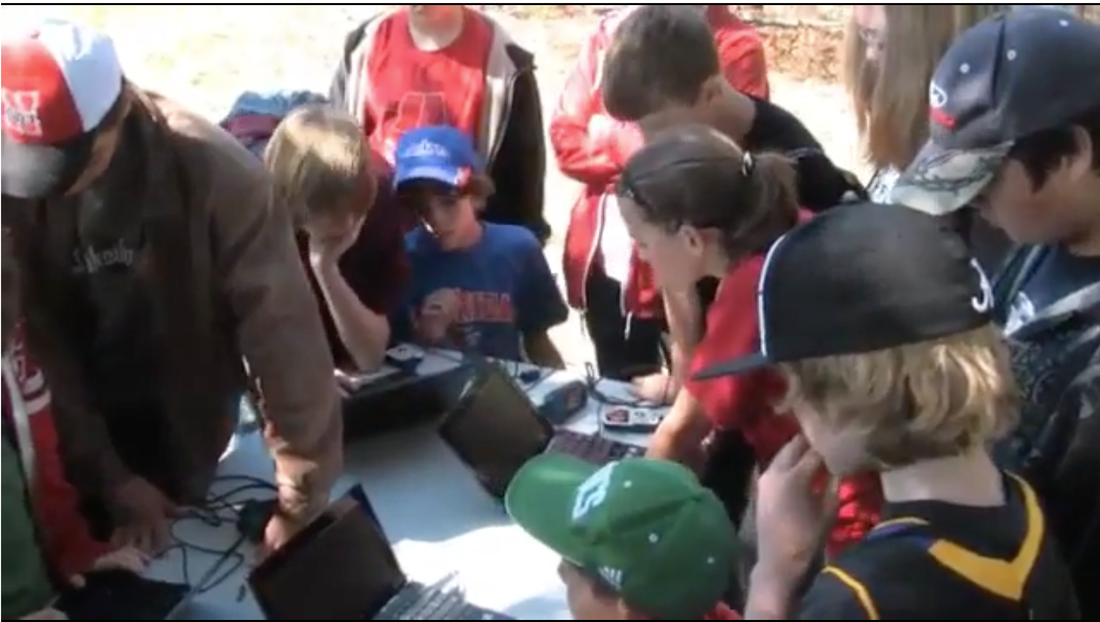- Engagement: The students are using the technology to focus on their learning task by connecting with the students in Germany to get authentic answers to their questions and discuss language. (6/6 Score)
- Enhancement: This project would be difficult to do without technology. The technology enhances the students opportunities to learn from students in Germany in a synchronous way, that could only be done via technology tools. (4/6 Score)
- Extension: The technology allows students to connect their learning of German language and culture to the real world of life and culture in German. (6/6 Score)
- Total Score= 16/18, Exceptional connection between the learning goals and technology used in the project. See here for more information on scoring results.
A German Teacher Creates Authentic Learning by Using Technology to Extend the Classroom Overseas3/30/2017 The German students from L’Anse Creuse High School – North in Macomb, MI, along with teacher James Ekdahl used Twitter and the European educational network of #edchatde to meet and network with Jan Hambsch, English teacher and multimedia consultant from Karlsruhe in Baden-Württemberg Germany. These American students participated in a live video chat with the students from the Josef Durler Schule in Rastatt, Germany to discuss language, culture, and societal questions. The project culminated in a video project where students sent videos about their daily life to each other. Teachers James Ekdahl and Jan Hambsch were also able to meet up in person the summer afterwards when the students from Michigan were visiting Heidelberg, Germany. The use of Twitter and educational professional networking resulted in a project that offered authentic educational connections in a real-world context that engaged students in a powerful way. This project meets the Triple E Framework in the following ways:
0 Comments
In this lesson by Trudy Denton in Westport, Connecticut, students are using statistical analysis to make predictions, hypothesis and conclusions about baseball based on authentic data. Rather than having students use made up data, the teacher took actual data for the students to analyze. She also made certain that there was no one correct answer, that the students would have to use higher-level thinking skills to prove their answer with evidence from the data. The students are using spreadsheets and Fathom software.
Total Score=13/18 (Link to understanding scores) Engagement: Students are working in pairs (co-use), the spreadsheets are specific to the math and students can create graphs and charts based on the spreadsheets to help them dive deeper into the math Score 5/6 Enhancement: The software allowed students to use higher-level thinking skills to analyze the data and meet the learning goals. This could be done with traditional tools but would be very difficult. Score 4/6 Extension: The statistics used come from real world data and students are hypothesizing about a possible real world question. Score 4/6 A second grade teacher, Beverly Ladd, from North Carolina is teaching Geography in a whole new way: Skype! Her classroom is trying to find 50 classes from other states to Skype with and share geography and cultural norms. She set up an open Google doc where classrooms can sign up to do a mystery Skype with her classroom. This is a wonderful way to use technology to extend learning and make it more authentic. Rather than reading about other states, learning from the local "experts" in an inquiry-based way is something that these students will remember, and this would be very difficult to do without the aid of technology!
A web-based project called the Michigan Student Caucus is a collaborative project between university students and middle and high school social studies students. The project supports a deep dive into politics, government and advocacy work. University students help to scaffold and support secondary students on their understanding of state government, by using authentic policies and real life issues in Michigan and the state government of Michigan. The secondary students are able to research policies, and even draft their own bill, which they introduce to the Michigan state government at the end of the semester long project. Students form all over the state of Michigan collaborate through the website, and through their co-construction of their own bills and policies based on authentic information from the state of Michigan.
Engagement: The website allows students to co-engage with other students in learning about government and drafting bills. The website helps them focus on the learning goals. Enhancement: University students are able to help scaffold and support the learning through the website discussion boards and private messaging. They can also personalize the learning for the secondary students through the website. Extension: The website allows the students access to work on real world policy. This assignment by Sara Romeyn of Bullis High School has always stood out as an extremely effective use of technology to meet learning goals. Sara has the students do a deep-dive into a historical character. They research the character's thoughts, ideas and writings. Then they create a Facebook FanPage about their character, updating it often and responding in character to other historical characters of their classmates. Sara encourages them to work outside of school hours, when they are already on Facebook to extend the learning. She also encourages them to consider how their character would respond current political issues. In the end, the students participate in a virtual salon, where they are all online, in character responding to each other's posts.
Engagement: The students are co-engaging through their characters by both asynchronously and synchronously responding to each other's Facebook posts. While Facebook can be distracting, by using a tool that the students are already engaging with outside of class, they will see their classmate's character's posts show up in the general feed and prompt them to respond. Enhancement: Facebook allows students to post different types of multi-media about their character and share their thoughts with others. It also allows the teacher to weigh in through replies and push the student's thinking. Facebook gives students an opportunity to be reflective and monitor their thinking. Note, the teacher should be modeling how to do this. Finally, Facebook allows a lot of conversation to be happening at one time, something that would be difficult to capture with only traditional learning tools. Extension: The way that Sara set up the assignment, allows students to connect with everyday political culture and historical character's perspectives. In addition, students can participate 24/7. Finally, the students learn how to have a positive but constructive dialog online about politics. In this lesson (via the TIMS website), middle school students studying animal habitats and behaviors were able to extend their learning by selecting the appropriate technology to document different animals in their natural habitat.
Engagement: Students co-use the technology tools. They are purposely selecting tools that help them meet their end goal (focus on the time-on-task). Enhancement: The tools allow the students to collect the data, as well as scaffold their understanding of the data (putting it into easy to read charts/graphs). Extension: The technology tools allow students to document the animals in their natural habitat and study them, using the authentic data that they collect. |
AuthorLiz Kolb is a clinical associate professor of education technologies at the University of Michigan in Ann Arbor. She works with over 150 preservice teachers every year on integrating technology into K-12 teaching. Categories
All
More Schools Using Triple E and Articles about #tripleE Kent ISD (MI)
Engaging the Rewired Brain Tech PD Blog Lafayette Jefferson High School (IN) #edtech Blog Noblesville Schools (IN) ISTE Ed Tek Hub West Bloomfield Schools (MI) From Texting to Teaching by Hyler and Hicks Van Buren Elementary School, Janesville (WI) About Education Article eSchoolNews Article Archives
October 2020
|





 RSS Feed
RSS Feed
